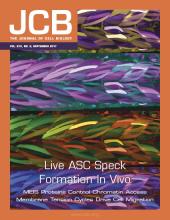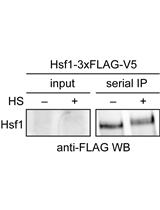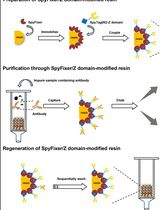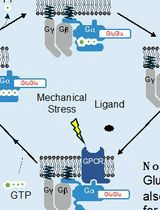- EN - English
- CN - 中文
An in vitro Microscopy-based Assay for Microtubule-binding and Microtubule-crosslinking by Budding Yeast Microtubule-associated Protein
利用芽殖酵母微管相关蛋白研究微管结合和微管交联的体外显微镜检测法
发布: 2018年12月05日第8卷第23期 DOI: 10.21769/BioProtoc.3110 浏览次数: 7263
评审: Pengpeng LiFarah HaqueJer-Sheng LIN
Abstract
In this protocol, we describe a simple microscopy-based method to assess the interaction of a microtubule-associated protein (MAP) with microtubules. The interaction between MAP and microtubules is typically assessed by a co-sedimentation assay, which measures the amount of MAP that co-pellets with microtubules by centrifugation, followed by SDS-PAGE analysis of the supernatant and pellet fractions. However, MAPs that form large oligomers tend to pellet on their own during the centrifugation step, making it difficult to assess co-sedimentation. Here we describe a microscopy-based assay that measures microtubule binding by direct visualization using fluorescently-labeled MAP, solving the limitations of the co-sedimentation assay. Additionally, we recently reported quantification of microtubule bundling by measuring the thickness of individual microtubule structures observed in the microscopy-based assay, making the protocol more advantageous than the traditional microtubule co-pelleting assay.
Keywords: Microtubule (微管)Background
Microtubules are dynamic polar filaments made up of polymerized tubulin subunits. Cells use microtubules to organize the cytosol and to build complex architectures necessary for cell growth and division. For instance, during interphase, microtubules act as molecular highways for motor proteins to manipulate the position of various cargoes in the cell. During mitosis, microtubules assemble the mitotic spindle to accomplish the critical task of chromosome segregation (Wadsworth and Khodjakov, 2004; Wadsworth et al., 2011). To date, we know that numerous regulators, including motor and non-motor microtubule-associated proteins (MAPs), interact with microtubules and participate in a variety of motile activities carried out by microtubules (Goshima and Scholey, 2010). In particular, many of these factors ensure that cells undergo proper mitotic progression, by helping to generate pulling and pushing forces on the microtubules for centrosome separation (Gonczy et al., 1999; Tanenbaum et al., 2008), nuclear envelope breakdown (Salina et al., 2002), mitotic spindle assembly (Rusan et al., 2002), chromosome capture and congression (Schmidt et al., 2005), spindle centering and positioning (Omer et al., 2018; Zulkipli et al., 2018), spindle checkpoint inactivation (Howell et al., 2001), and spindle elongation (Sharp et al., 1999; Khmelinskii et al., 2009).
We recently showed that She1, a MAP that regulates dynein motility along microtubule tracks (Markus et al., 2012), also crosslinks spindle microtubules to help maintain spindle integrity during spindle positioning in budding yeast (Zhu et al., 2017). In this bio-protocol, we describe a sensitive fluorescence-based assay that enables visualization and quantification of microtubule binding and crosslinking activities exhibited by a MAP. Because this assay does not need biochemical quantities of purified MAPs, we believe that it represents a significant advantage over the traditional microtubule co-sedimentation assay.
Materials and Reagents
- Avant 1.7 ml microcentrifuge tubes (MIDSCI, catalog number: AVSS1700)
- Pipette tips, 20 µl (Rainin Instrument, LLC, catalog number: 17005091)
- Pipette tips, 250 µl (Rainin Instrument, LLC, catalog number: 17005093)
- Razor blades (Fisher Scientific, catalog number: 12640)
- Microcentrifuge tube rack (Fisher Scientific, catalog number: 22-313630)
- Scotch double-sided tape, ¾ in. x 400 in. (3M)
- Microscope slides, 3 in. x 1 in. (Fisher Scientific, catalog number: 12518100A3)
- Cover glass, No. 1.5, 30 mm x 22 mm (Fisher Scientific, catalog number: 12544A)
- Filter forcep (EMD Millipore, catalog number: XX6200006P)
- Kimwipe (Fisher Scientific, catalog number: 06666A)
- Microscope lens paper, 4 in. x 6 in. sheets (Fisher Scientific, catalog number: 11996)
- Unlabeled porcine tubulin, > 99% pure, 1 mg (Cytoskeleton, Inc., catalog number: T240) (store at -80 °C)
- HiLyte Fluor 488 labeled porcine tubulin, 20 µg (Cytoskeleton, Inc., catalog number: TL488M) (store at -80 °C)
- Rhodamine labeled porcine tubulin, 20 µg (Cytoskeleton, Inc., catalog number: TL590M) (store at -80 °C)
- 100 mM GTP (Cytoskeleton, Inc., catalog number: BST06-010) (store at -20 °C)
- 10 mM Taxol (Cytoskeleton, Inc., catalog number: TXD01) (store at -20 °C)
- Precision Red Advanced Protein Assay Reagent (Cytoskeleton, Inc., catalog number: ADV02) (store at room temperature)
- PIPES (Sigma-Aldrich, catalog number: P1851) (store at room temperature)
- EGTA (Fisher Scientific, catalog number: O2783-100) (store at room temperature)
- Magnesium Chloride Hexahydrate (Fisher Scientific, catalog number: BP214-500)
- Ultrapure water from Milli-Q® Advantage A10 Water Purification System (Millipore Sigma)
- THETM alpha Tubulin Antibody, mAb, mouse (GenScript, catalog number: A01410) (store at -20 °C)
- Pluronic F-127, 100 g (Anatrace, catalog number: P305) (store at room temperature)
- Carl Zeiss ImmersolTM 518 F Immersion Oil (Fisher Scientific, catalog number: 1262466A) (store at room temperature)
- PEM Buffer (see Recipes)
- Blocking buffer (see Recipes)
Equipment
- Ice bucket (Fisher Scientific, catalog number: 07210123)
- Milli-Q® Advantage A10 Water Purification System (Millipore Sigma)
- Sorvall centrifuge equipped with S120-AT2 rotor (Thermo Fisher Scientific, model: Discovery)
- 37 °C incubator (Fisher Scientific, catalog number: 11690525D)
- Microcentrifuge (Eppendorf, model: 5424)
- Inverted fluorescence microscope equipped with Perfect Focus System and a 100x/1.49 NA objective (Nikon, model: Ti-E)
- Laser launch system with 405/488/561/640 nm wavelengths at 15 mW per line (Nikon, model: LUN4)
- Electron multiplying CCD camera (Andor Technology, model: iXon 888)
- GFP filter cube set for imaging HiLyte Fluor 488 or Alexa Fluor 488 fluorescence (Chroma Technology Corp., catalog number: 49002)
- TRITC filter cube set for imaging rhodamine or TMR fluorescence (Chroma Technology Corp., catalog number: 49008)
- HP workstation with 3.5 GHz 6 core Xeon processor, 64 GB memory, 1 TB hard drive, and 64bit Windows 7 (Micro Video Instruments, Inc., catalog number: 99909)
- Pipet-Lite LTS pipette L-20XLS+ (Rainin Instrument, LLC, catalog number: 17014392)
- Pipet-Lite LTS pipette L-200XLS+ (Rainin Instrument, LLC, catalog number: 17014391)
Software
- NIS-Elements Advanced Research (Nikon) (https://www.nikoninstruments.com/Products/Software/NIS-Elements-Advanced-Research)
- ImageJ (NIH, https://imagej.nih.gov/ij/download.html)
- KaleidaGraph (http://www.synergy.com/wordpress_650164087/kaleidagraph/)
Procedure
文章信息
版权信息
© 2018 The Authors; exclusive licensee Bio-protocol LLC.
如何引用
Readers should cite both the Bio-protocol article and the original research article where this protocol was used:
- Zhu, Y., Tan, W. and Lee, W. (2018). An in vitro Microscopy-based Assay for Microtubule-binding and Microtubule-crosslinking by Budding Yeast Microtubule-associated Protein. Bio-protocol 8(23): e3110. DOI: 10.21769/BioProtoc.3110.
- Zhu, Y., An, X., Tomaszewski, A., Hepler, P. K. and Lee, W. L. (2017). Microtubule cross-linking activity of She1 ensures spindle stability for spindle positioning. J Cell Biol 216: 2759-2775.
分类
微生物学 > 微生物细胞生物学 > 细胞骨架间的相互作用
生物化学 > 蛋白质 > 相互作用 > 蛋白质-蛋白质相互作用
细胞生物学 > 细胞成像 > 荧光
您对这篇实验方法有问题吗?
在此处发布您的问题,我们将邀请本文作者来回答。同时,我们会将您的问题发布到Bio-protocol Exchange,以便寻求社区成员的帮助。
Share
Bluesky
X
Copy link














